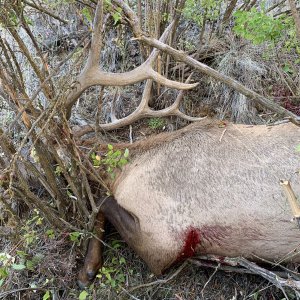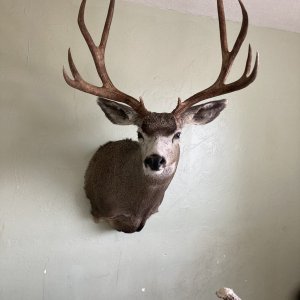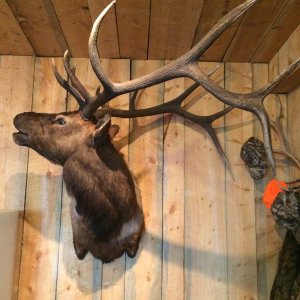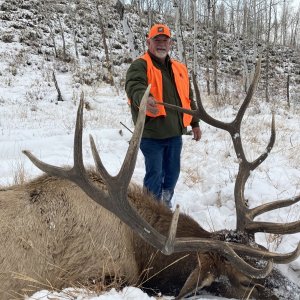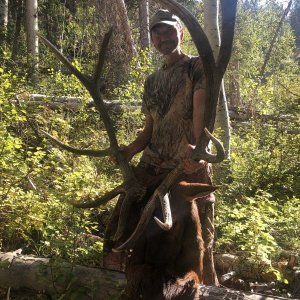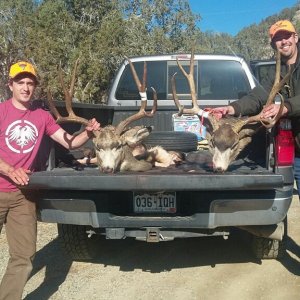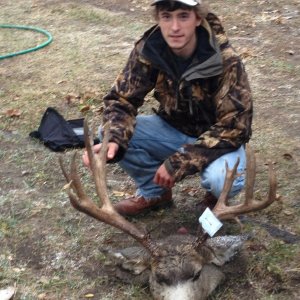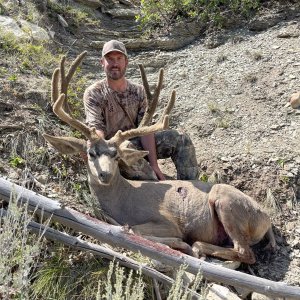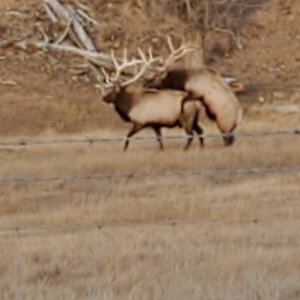Hiker of the Woods
Active Member
- Messages
- 623
I am looking for a great all around hunting knife for big game. Here is a list of knives that I was looking at and was wondering what thoughts or experiences anyone has had with these knives. Thanks for helping me decide on what knife to buy.
A.G. Russell? Cocobolo San Mai Drop Point ($235)
I have been drawing pictures of knives for all of seventy years, but it was not until the late 1960s when Robert W. (Bob) Loveless, the World's premier designer of hunting and combat knives, taught me how he developed a knife design that I began to design instead of just drawing pictures.
This Drop Point Hunter has had more serious thought than I have ever given a hunting knife before. The drop point blade with a core of VG-10 at 59-61 Rc., supported by a softer stainless on each side, is dropped into a forward tilt to make working inside an animal's hide easier, with less possibility for error that might damage the hide. There is a tiny choil that allows the entire edge to be sharpened. The amount of curve (belly) in the forward part of the blade is important, both for skinning and for general cutting. The 4-1/8" blade is long enough to skin any animal that you have the patience to skin.
Both the shape and the design of the handle deserve your attention as well. The hilt (guard) is quite trim, just long enough to protect your hand from the edge, yet not long enough to get in the way when you are doing delicate work. And it is wide enough to be engraved. The butt is there not only for looks but also to bring the balance point back onto the handle about an inch from the blade, putting more weight in your hand. This gives the blade a feather touch so you have total control of the edge and the point. The handle itself is slim at the front, with a swell in the center and a flare at the butt for comfort and control. This knife will fit your hand as no other knife has. The blade measures 1-3/16" wide at the widest point. The knife measures 8-1/2" tip to butt and weighs about 6.5 oz. Made in Japan. Includes a high quality brown leather sheath.
A. G. Russell? San Mai Drop Point Hunter Ebony ($295)
One of the advantages to having our own knife shop is the ability to produce knives with many different handle materials to suit customers taste. We have created the A. G. Russell? San Mai Drop Point Hunter with this program in mind. While there are many different handle materials available, we have chosen three different ones (Ebony, Giraffe Bone and Pink Ivory), each with mosaic pins of stainless and copper to complement the color of the handle scales. The ebony is an exotic wood from Mozambique, the pink ivory is a dense wood from South Africa with a naturally occurring pink color and the Giraffe Bone is in its natural color. It has been stabilized but not dyed.
The 4-1/8" drop point blade with a core of VG-10 at 59-61 Rc., supported by a softer stainless on each side, is designed to skin any animal you have the patience to skin. There is a tiny choil that allows the entire edge to be sharpened. The hilt (guard) is quite trim, just long enough to protect your hand from the edge, yet not long enough to get in the way when you are doing delicate work. The weight of the butt brings the balance point back onto the handle about an inch from the blade, putting more weight in your hand. This gives the blade a feather touch so you have total control of the edge and the point. The handle itself is slim at the front, with a swell in the center and a flare at the butt for comfort and control. Measures 8-1/2" tip to butt and weighs about 6.5 oz. Made in Japan and finished in our shop in Rogers, Arkansas. Includes a high quality handmade brown leather sheath
D. H. Russell Canadian Camp Survival Knife ($90)
In the late 1950s, D. H. Russell, owner of a cutlery store in Toronto, designed the Original Canadian Belt Knife. Demand for this design was so great that he brought an experienced cutler from Czechoslovakia to make the knives. Rudolf Grohmann and his family came to Canada, founded Grohmann Knives, of Pictou, Nova Scotia, and have produced all of the D. H. Russell Belt Knives from the beginning.
The Canadian Survival Knife is a large knife with a 5-1/2" blade of 3/16" high carbon stainless, with Rosewood handles. Measures 10-1/4" overall. Weighs 7.2 oz. Useful for camp chores and as a big game butchering and skinning tool. A favorite among big game hunters the world over. Leather Sheath.
Breeden knives- Not sure what model or prices.
Canal Street Cutlery D'Holder Integral Hunter ($225)
Late in 2007, Canal Street Cutlery introduced an exciting new design by well-known knifemaker D'Alton Holder. The cast integral hilt/bolster and 3-1/2" mirror polished drop point blade is 19C27 Swedish stainless at 60-62 Rc. For this A. G. Russell? Exclusive, the handle scales are our own carefully selected cocobolo with a coined nickel silver Canal Street shield. This is a great knife for the collector or for the hunter with a great edge holding steel that will hold up extremely well in the field. Measures 7-3/8" tip to butt and weighs 5.4 oz. The serial number, 19C27 and U. S. A is marked on the spine of the blade otherwise the blade is unmarked. Includes a brown leather pouch style belt sheath. Made in the U.S.A.
Dozier Buffalo River Hunter Green Micarta ($215)
The Dozier Buffalo River Hunter was introduced late in 2005. It is a drop point hunter that was designed for A. G. Russell customers. At the time it was introduced, Desert Ironwood was plentiful. It is a wonderful handle material, but has become increasingly hard to find forcing Bob to look for other suitable handle material. He has found a source of Cocobolo that has as much striking contrast in grain, perhaps more, as the finest Desert Ironwood. Buffalo Hunters are now available with Cocolobo and Green Linen Micarta?. Like all of Bob's standard hollow ground hunting knives, these are hand ground in Bob's shop on grinders designed and built by him.
The blade shape is one of the best drop point designs I have ever seen. It is long enough to be a general hunting and camping knife with enough belly to make a good skinning knife but enough straight for splitting kindling and making fuzz sticks. There is no such thing as a knife that will do everything, but this one comes as close as you can get in a hunting knife. The blade measures 3-3/4" long and 15/16" wide of D-2 tool steel with Bob's personal fantastic edge holding heat-treat (60-61 Rc.), possibly the sharpest and best edge holding knife in the knife world today. Measures 8-3/16" tip to butt and weighs 4.9 oz. with Micarta? handle and 4.5 oz. with Cocobolo. Includes a Kydex? sheath of Bob's own design and made in his shop. As great a value in a handmade hunting knife as you can find. We attempt to keep Dozier knives that we include in our catalog on our shelves. They are so popular that we often run out.
Dozier Professional Guides Knife - Wilderness Sheath ($270)
Bob Dozier's Professional Guide's Knife was developed for the professional packer or guide who works in remote areas and does not want to carry more than one knife. This knife is large enough to do the whole job on any big game animal as well as camp chores. It will also have a good edge when other knives have become dull. Using his standard D2 at 60+ Rc, which he heat treats in his own shop to assure quality control, Bob has produced a man sized knife. Both the blade and the handle are larger than most of his knives. This knife is perfectly suited to the man with large hands, or regular hands, with big jobs to do.
The 4-3/4" clip point blade of 3/16" D2 hardened to 60-61 Rc. Black Micarta? handle scales and aircraft alloy pins and lanyard hole liner. Measures 9-3/16" tip to butt and weighs 6.9 oz. Available with Bob's Wilderness sheath with a nylon webbing belt loop.
Dozier Yukon Pro Skinner ($215)
The Bob Dozier Yukon Pro Skinner with Black Micarta? handle and horizontal belt sheath is a knife for the serious hunter, the man who makes his living in the woods. Instead of the traditional leather sheath that would over time get limp and rot, Bob builds precisely fitted sheaths of Kydex? for each knife. Without attention, the sheath will last as long as the knife, your lifetime and your son's. The knife itself is made of 1/8" hollow ground D2, hardened by Bob to 60-61Rc. Almost without exception, they are found to measure 60.5 Rc. It is not unusual for one of these knives to keep a usable edge through 6-10 big animals, not field dressing, but breaking briskets and reducing the animal to transportable size. The average hunter could sharpen his knife once a season and do fine. The pro will want to carry a small diamond sharpener or the A. G. Russell Field Sharpener to touch up the blade when many animals are coming into camp.
Better than any production knife and far less expensive than most of the handmade knives you will see. I recommend it highly.
With the 3-1/2" blade and the almost 7-7/8" overall length, this is about the minimum working knife for professionals, any one but Dozier would have to make it bigger. The handle is shaped into the distinctive form that Dozier uses for working knives, (as distinct from good looking knives). This blade and handle merge into a useful tool that could be used hour after hour, functioning efficiently and safely. Weighs 5.7 oz. in sheath.
With the 3-1/2" blade and the almost 7-7/8" overall length, this is about the minimum working knife for professionals, any one but Dozier would have to make it bigger. The handle is shaped into the distinctive form that Dozier uses for working knives, (as distinct from good looking knives). This blade and handle merge into a useful tool that could be used hour after hour, functioning efficiently and safely. Weighs 5.7 oz. in sheath.
Dozier Straight Personal Coral Rucarta? ($195)
To most of the people reading this Bob Dozier's knives speak for themselves. The D2 high-carbon, high-chrome tool steel, hardened to 60-62 Rockwell, really holds an edge and the Dozier Kydex? sheaths that are molded to each knife hold the knife until the owner removes it with the magic release that Bob has designed into it. The flawless fitting of the handle material, in this case a Coral Rucarta?, and the no frills finish that allows a handmade knife to be sold at prices that might grace many of today's production knives, make this a very attractive knife from many points of view. These knives can be ordered with left handed sheaths.
Bob's concept of a personal knife is a knife that can be carried day in and day out; a knife that is never in the way but is always instantly available. 2-7/8" blade, 6-3/4" overall length. Horizontal black Kydex? sheath. Weighs 4.4 oz.
Dozier White River Skinner ($205)
This White River Skinner, named for the White River National Forest in Colorado, is as suitable for skinning Beaver as it is for skinning Grizzly or Moose.
Once again, Bob Dozier has taken the complex and made it look simple. The subtle relationship between the cutting edge, the skinning belly, and the angle and shape of the handle, result in a knife that looks as if anyone could have designed it. Only when it is in the hand can you begin to appreciate how this knife will function in the field.
Using his favorite knife steel, D2, a high-carbon, high-chrome die steel, hardened to 60-61 Rc, Bob delivers a knife that will hold an edge better than any other in his price class. This model is handled in a black linen Micarta?. (Previously available only in Brown Linen Micarta?.)
The horizontal Kydex sheath is Bob's design, and utilizes his own break-out latch. You only have to put your thumb on top of the belt loop when you grip the handle and the knife comes easily from the sheath. This is as solid and safe a sheath as you can find. 3-1/2" skinning blade of 1/8" D2 stock. Overall length is 7-3/4". Weighs 6.2 oz. with sheath.
Dozier Slim Outdoorsman - Natural Rucarta Handle ($215)
Bob Dozier has been one of America's foremost makers of handmade knives since about 1968. He makes some of the finest and most practical handmade knives you'll find. For many years, Bob made highly finished knives for sale to the public while making reasonably priced knives for his fellow iron-workers. When he returned to full time knifemaking about 1988, it only took him a year of making highly finished knives to decide that what he really wanted to do was make the kind of knives he makes today. A Dozier knife will work all day, and still have a better edge than most knives you can buy. Each Dozier fixed blade knife includes the finest Kydex? sheath in the world, fitted to your knife.
Dozier Professional Guides Knife ($235)
The knife for the professional packer or guide who works in remote areas and does not want to carry more than one knife. This knife is large enough to do the whole job on any big game animal as well as camp chores. It will also have a good edge when other knives have become dull. Using his standard D2 at 60+ Rc, Bob produces a man sized knife with both the blade and the handle larger than most of his knives. This knife is perfectly suited to the man with large hands, or regular hands, but big jobs to do. 4-3/4" clip point blade made of D2 hardened to 60-61 Rc, total length 9-3/16". Made of 3/16" blade stock. Black Micarta? handle scales, pins and lanyard hole liner of aircraft alloy. Weighs 6.9 oz. Each knife is individually fitted with a Dozier Vertical Kydex? sheath.
Dozier Professional Skinner ($235)
The Dozier Professional Skinner is shaped to perform the maximum skinning job while allowing its use for most other camp chores. This is the knife for the man who wants the very best professional tool available. There will be no knife in the camp that will out perform it at skinning. 7-1/2" overall length with approximately 3-1/2" blade of D2 at 60-61 Rc. (the blade will sometimes vary since they are handmade knives). Horizontal Kydex belt sheath. Weighs 5.3 oz.
Dozier Master Skinner - Black Rucarta? ($235)
This is the drop point blade carried to its ultimate conclusion. A knife suited to the skinning of any animal on this or any other continent. The 3-1/2" by 1-1/8" blade of D2 at 60-61 Rc. will flay everything from a small whitetail to a 20 foot salt water crock with the same ease, and will hold an edge beyond your experience. Bob Dozier's personal heat-treat of D2 is fast becoming legendary among knife aficionados (those of us who love knives and great edge holding). This blade has a great skinning curve beneath the classic drop point and a satin finish well suited to the use the knife can expect. The handle has the ergonomic, "shaped for use" contours you would expect from Bob Dozier. It is not intended for those with small hands, this is truly "Man Sized". We are happy to offer either Black Rucarta handles or handles of our own Golden Maple Burl. The knife measures 8" overall and has a vertical sheath of Kydex? which allows it to be carried safely in front of the hip. Bob has put a lot of thought into this knife, designed exclusively for the A. G. Russell catalog. Knife weighs 6.4 oz.
A.G. Russell? Cocobolo San Mai Drop Point ($235)
I have been drawing pictures of knives for all of seventy years, but it was not until the late 1960s when Robert W. (Bob) Loveless, the World's premier designer of hunting and combat knives, taught me how he developed a knife design that I began to design instead of just drawing pictures.
This Drop Point Hunter has had more serious thought than I have ever given a hunting knife before. The drop point blade with a core of VG-10 at 59-61 Rc., supported by a softer stainless on each side, is dropped into a forward tilt to make working inside an animal's hide easier, with less possibility for error that might damage the hide. There is a tiny choil that allows the entire edge to be sharpened. The amount of curve (belly) in the forward part of the blade is important, both for skinning and for general cutting. The 4-1/8" blade is long enough to skin any animal that you have the patience to skin.
Both the shape and the design of the handle deserve your attention as well. The hilt (guard) is quite trim, just long enough to protect your hand from the edge, yet not long enough to get in the way when you are doing delicate work. And it is wide enough to be engraved. The butt is there not only for looks but also to bring the balance point back onto the handle about an inch from the blade, putting more weight in your hand. This gives the blade a feather touch so you have total control of the edge and the point. The handle itself is slim at the front, with a swell in the center and a flare at the butt for comfort and control. This knife will fit your hand as no other knife has. The blade measures 1-3/16" wide at the widest point. The knife measures 8-1/2" tip to butt and weighs about 6.5 oz. Made in Japan. Includes a high quality brown leather sheath.
A. G. Russell? San Mai Drop Point Hunter Ebony ($295)
One of the advantages to having our own knife shop is the ability to produce knives with many different handle materials to suit customers taste. We have created the A. G. Russell? San Mai Drop Point Hunter with this program in mind. While there are many different handle materials available, we have chosen three different ones (Ebony, Giraffe Bone and Pink Ivory), each with mosaic pins of stainless and copper to complement the color of the handle scales. The ebony is an exotic wood from Mozambique, the pink ivory is a dense wood from South Africa with a naturally occurring pink color and the Giraffe Bone is in its natural color. It has been stabilized but not dyed.
The 4-1/8" drop point blade with a core of VG-10 at 59-61 Rc., supported by a softer stainless on each side, is designed to skin any animal you have the patience to skin. There is a tiny choil that allows the entire edge to be sharpened. The hilt (guard) is quite trim, just long enough to protect your hand from the edge, yet not long enough to get in the way when you are doing delicate work. The weight of the butt brings the balance point back onto the handle about an inch from the blade, putting more weight in your hand. This gives the blade a feather touch so you have total control of the edge and the point. The handle itself is slim at the front, with a swell in the center and a flare at the butt for comfort and control. Measures 8-1/2" tip to butt and weighs about 6.5 oz. Made in Japan and finished in our shop in Rogers, Arkansas. Includes a high quality handmade brown leather sheath
D. H. Russell Canadian Camp Survival Knife ($90)
In the late 1950s, D. H. Russell, owner of a cutlery store in Toronto, designed the Original Canadian Belt Knife. Demand for this design was so great that he brought an experienced cutler from Czechoslovakia to make the knives. Rudolf Grohmann and his family came to Canada, founded Grohmann Knives, of Pictou, Nova Scotia, and have produced all of the D. H. Russell Belt Knives from the beginning.
The Canadian Survival Knife is a large knife with a 5-1/2" blade of 3/16" high carbon stainless, with Rosewood handles. Measures 10-1/4" overall. Weighs 7.2 oz. Useful for camp chores and as a big game butchering and skinning tool. A favorite among big game hunters the world over. Leather Sheath.
Breeden knives- Not sure what model or prices.
Canal Street Cutlery D'Holder Integral Hunter ($225)
Late in 2007, Canal Street Cutlery introduced an exciting new design by well-known knifemaker D'Alton Holder. The cast integral hilt/bolster and 3-1/2" mirror polished drop point blade is 19C27 Swedish stainless at 60-62 Rc. For this A. G. Russell? Exclusive, the handle scales are our own carefully selected cocobolo with a coined nickel silver Canal Street shield. This is a great knife for the collector or for the hunter with a great edge holding steel that will hold up extremely well in the field. Measures 7-3/8" tip to butt and weighs 5.4 oz. The serial number, 19C27 and U. S. A is marked on the spine of the blade otherwise the blade is unmarked. Includes a brown leather pouch style belt sheath. Made in the U.S.A.
Dozier Buffalo River Hunter Green Micarta ($215)
The Dozier Buffalo River Hunter was introduced late in 2005. It is a drop point hunter that was designed for A. G. Russell customers. At the time it was introduced, Desert Ironwood was plentiful. It is a wonderful handle material, but has become increasingly hard to find forcing Bob to look for other suitable handle material. He has found a source of Cocobolo that has as much striking contrast in grain, perhaps more, as the finest Desert Ironwood. Buffalo Hunters are now available with Cocolobo and Green Linen Micarta?. Like all of Bob's standard hollow ground hunting knives, these are hand ground in Bob's shop on grinders designed and built by him.
The blade shape is one of the best drop point designs I have ever seen. It is long enough to be a general hunting and camping knife with enough belly to make a good skinning knife but enough straight for splitting kindling and making fuzz sticks. There is no such thing as a knife that will do everything, but this one comes as close as you can get in a hunting knife. The blade measures 3-3/4" long and 15/16" wide of D-2 tool steel with Bob's personal fantastic edge holding heat-treat (60-61 Rc.), possibly the sharpest and best edge holding knife in the knife world today. Measures 8-3/16" tip to butt and weighs 4.9 oz. with Micarta? handle and 4.5 oz. with Cocobolo. Includes a Kydex? sheath of Bob's own design and made in his shop. As great a value in a handmade hunting knife as you can find. We attempt to keep Dozier knives that we include in our catalog on our shelves. They are so popular that we often run out.
Dozier Professional Guides Knife - Wilderness Sheath ($270)
Bob Dozier's Professional Guide's Knife was developed for the professional packer or guide who works in remote areas and does not want to carry more than one knife. This knife is large enough to do the whole job on any big game animal as well as camp chores. It will also have a good edge when other knives have become dull. Using his standard D2 at 60+ Rc, which he heat treats in his own shop to assure quality control, Bob has produced a man sized knife. Both the blade and the handle are larger than most of his knives. This knife is perfectly suited to the man with large hands, or regular hands, with big jobs to do.
The 4-3/4" clip point blade of 3/16" D2 hardened to 60-61 Rc. Black Micarta? handle scales and aircraft alloy pins and lanyard hole liner. Measures 9-3/16" tip to butt and weighs 6.9 oz. Available with Bob's Wilderness sheath with a nylon webbing belt loop.
Dozier Yukon Pro Skinner ($215)
The Bob Dozier Yukon Pro Skinner with Black Micarta? handle and horizontal belt sheath is a knife for the serious hunter, the man who makes his living in the woods. Instead of the traditional leather sheath that would over time get limp and rot, Bob builds precisely fitted sheaths of Kydex? for each knife. Without attention, the sheath will last as long as the knife, your lifetime and your son's. The knife itself is made of 1/8" hollow ground D2, hardened by Bob to 60-61Rc. Almost without exception, they are found to measure 60.5 Rc. It is not unusual for one of these knives to keep a usable edge through 6-10 big animals, not field dressing, but breaking briskets and reducing the animal to transportable size. The average hunter could sharpen his knife once a season and do fine. The pro will want to carry a small diamond sharpener or the A. G. Russell Field Sharpener to touch up the blade when many animals are coming into camp.
Better than any production knife and far less expensive than most of the handmade knives you will see. I recommend it highly.
With the 3-1/2" blade and the almost 7-7/8" overall length, this is about the minimum working knife for professionals, any one but Dozier would have to make it bigger. The handle is shaped into the distinctive form that Dozier uses for working knives, (as distinct from good looking knives). This blade and handle merge into a useful tool that could be used hour after hour, functioning efficiently and safely. Weighs 5.7 oz. in sheath.
With the 3-1/2" blade and the almost 7-7/8" overall length, this is about the minimum working knife for professionals, any one but Dozier would have to make it bigger. The handle is shaped into the distinctive form that Dozier uses for working knives, (as distinct from good looking knives). This blade and handle merge into a useful tool that could be used hour after hour, functioning efficiently and safely. Weighs 5.7 oz. in sheath.
Dozier Straight Personal Coral Rucarta? ($195)
To most of the people reading this Bob Dozier's knives speak for themselves. The D2 high-carbon, high-chrome tool steel, hardened to 60-62 Rockwell, really holds an edge and the Dozier Kydex? sheaths that are molded to each knife hold the knife until the owner removes it with the magic release that Bob has designed into it. The flawless fitting of the handle material, in this case a Coral Rucarta?, and the no frills finish that allows a handmade knife to be sold at prices that might grace many of today's production knives, make this a very attractive knife from many points of view. These knives can be ordered with left handed sheaths.
Bob's concept of a personal knife is a knife that can be carried day in and day out; a knife that is never in the way but is always instantly available. 2-7/8" blade, 6-3/4" overall length. Horizontal black Kydex? sheath. Weighs 4.4 oz.
Dozier White River Skinner ($205)
This White River Skinner, named for the White River National Forest in Colorado, is as suitable for skinning Beaver as it is for skinning Grizzly or Moose.
Once again, Bob Dozier has taken the complex and made it look simple. The subtle relationship between the cutting edge, the skinning belly, and the angle and shape of the handle, result in a knife that looks as if anyone could have designed it. Only when it is in the hand can you begin to appreciate how this knife will function in the field.
Using his favorite knife steel, D2, a high-carbon, high-chrome die steel, hardened to 60-61 Rc, Bob delivers a knife that will hold an edge better than any other in his price class. This model is handled in a black linen Micarta?. (Previously available only in Brown Linen Micarta?.)
The horizontal Kydex sheath is Bob's design, and utilizes his own break-out latch. You only have to put your thumb on top of the belt loop when you grip the handle and the knife comes easily from the sheath. This is as solid and safe a sheath as you can find. 3-1/2" skinning blade of 1/8" D2 stock. Overall length is 7-3/4". Weighs 6.2 oz. with sheath.
Dozier Slim Outdoorsman - Natural Rucarta Handle ($215)
Bob Dozier has been one of America's foremost makers of handmade knives since about 1968. He makes some of the finest and most practical handmade knives you'll find. For many years, Bob made highly finished knives for sale to the public while making reasonably priced knives for his fellow iron-workers. When he returned to full time knifemaking about 1988, it only took him a year of making highly finished knives to decide that what he really wanted to do was make the kind of knives he makes today. A Dozier knife will work all day, and still have a better edge than most knives you can buy. Each Dozier fixed blade knife includes the finest Kydex? sheath in the world, fitted to your knife.
Dozier Professional Guides Knife ($235)
The knife for the professional packer or guide who works in remote areas and does not want to carry more than one knife. This knife is large enough to do the whole job on any big game animal as well as camp chores. It will also have a good edge when other knives have become dull. Using his standard D2 at 60+ Rc, Bob produces a man sized knife with both the blade and the handle larger than most of his knives. This knife is perfectly suited to the man with large hands, or regular hands, but big jobs to do. 4-3/4" clip point blade made of D2 hardened to 60-61 Rc, total length 9-3/16". Made of 3/16" blade stock. Black Micarta? handle scales, pins and lanyard hole liner of aircraft alloy. Weighs 6.9 oz. Each knife is individually fitted with a Dozier Vertical Kydex? sheath.
Dozier Professional Skinner ($235)
The Dozier Professional Skinner is shaped to perform the maximum skinning job while allowing its use for most other camp chores. This is the knife for the man who wants the very best professional tool available. There will be no knife in the camp that will out perform it at skinning. 7-1/2" overall length with approximately 3-1/2" blade of D2 at 60-61 Rc. (the blade will sometimes vary since they are handmade knives). Horizontal Kydex belt sheath. Weighs 5.3 oz.
Dozier Master Skinner - Black Rucarta? ($235)
This is the drop point blade carried to its ultimate conclusion. A knife suited to the skinning of any animal on this or any other continent. The 3-1/2" by 1-1/8" blade of D2 at 60-61 Rc. will flay everything from a small whitetail to a 20 foot salt water crock with the same ease, and will hold an edge beyond your experience. Bob Dozier's personal heat-treat of D2 is fast becoming legendary among knife aficionados (those of us who love knives and great edge holding). This blade has a great skinning curve beneath the classic drop point and a satin finish well suited to the use the knife can expect. The handle has the ergonomic, "shaped for use" contours you would expect from Bob Dozier. It is not intended for those with small hands, this is truly "Man Sized". We are happy to offer either Black Rucarta handles or handles of our own Golden Maple Burl. The knife measures 8" overall and has a vertical sheath of Kydex? which allows it to be carried safely in front of the hip. Bob has put a lot of thought into this knife, designed exclusively for the A. G. Russell catalog. Knife weighs 6.4 oz.







